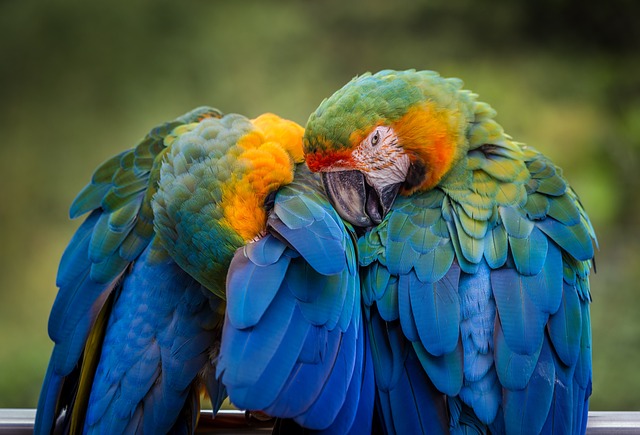Introduction
Parrots are one of the most fascinating and colorful creatures on our planet. Known for their vibrant plumage and remarkable intelligence, these birds have captured the hearts of bird enthusiasts and pet owners alike. This article aims to provide an in-depth look into the world of parrots, from their diverse species and physical characteristics to their behavior, care, and conservation.
An Overview of Parrot Species
The world of parrots is incredibly diverse, with over 350 species belonging to the order Psittaciformes. They vary widely in size, color, habitat, and behavior, making them a fascinating subject for bird lovers and researchers alike. Some of the most iconic parrot species include the African Grey, Macaw, Cockatoo, Lovebird, and Budgerigar, each with its unique traits and characteristics.
African Grey Parrots are often celebrated for their extraordinary intelligence and ability to mimic human speech. Native to the rainforests of West and Central Africa, these birds are known for their understated yet elegant grey plumage and a striking red tail. Macaws, on the other hand, are the epitome of vibrant beauty, featuring an array of dazzling colors from bright blue to fiery red. They are often found in the tropical regions of South America and are notable for their large size and powerful beaks.
Cockatoos are easily recognizable by their elaborate crests and predominantly white, grey, or black plumage. Originating from Australia and nearby islands, they are social birds known for their affectionate nature. Lovebirds, native to Africa, are petite, brightly colored, and often seen in pairs, reflecting their monogamous tendencies. Budgerigars, or budgies, are small Australian parrots that have become one of the most popular pet birds worldwide due to their friendly demeanor and ease of care.
This overview merely scratches the surface of the rich and varied world of parrots. Each species offers its unique blend of characteristics, making parrots one of the most intriguing and diverse avian families in the world.

Physical Characteristics
Parrots are visually stunning creatures, and their physical characteristics go beyond their vividly colored feathers. Understanding the anatomy of a parrot provides valuable insights into their behaviors, abilities, and needs.
One of the most distinguishing features of a parrot is its beak. Unlike many other birds, parrots have strong, curved beaks designed for a wide range of functions. These beaks are incredibly powerful and versatile, capable of cracking hard nuts, tearing flesh, and even manipulating objects. The upper mandible is more mobile than the lower, allowing for a high degree of precision. Many parrot owners are amazed by their bird’s ability to use its beak almost like a third hand, for tasks as delicate as preening or as demanding as climbing.
Just below the beak, you’ll find a parrot’s tongue, which is thick and muscular. This helps them manipulate food and is also used in vocalization for some species. The tongue works in conjunction with the beak to taste, manipulate, and ingest food, offering another example of the parrot’s adaptability.
The feet of parrots are equally specialized. Known as zygodactyl feet, two toes face forward, and two face backward, allowing them to grasp and handle objects skillfully. This toe arrangement is particularly useful for climbing and holding onto branches, as well as handling food. Many parrots use their feet in coordination with their beaks to eat, manipulate toys, or even perform tricks.
Of course, one cannot discuss a parrot’s physical characteristics without mentioning its feathers. Beyond their stunning visual appeal, feathers serve practical functions such as insulation, camouflage, and flight. Parrots also have specialized feathers that produce powder, used for cleaning and waterproofing their plumage. Additionally, many parrot species have a crest of elongated feathers on their heads that they can raise or lower to communicate their emotional state.
The physical characteristics of parrots are not just ornamental but also highly functional, aiding them in their complex social interactions, dietary needs, and locomotion. Each feature, from the curve of the beak to the arrangement of their toes, reflects millions of years of evolution, perfecting their ability to interact with their environment in versatile and effective ways. Understanding these aspects of parrot anatomy not only enhances our appreciation of their beauty but also informs better care and conservation efforts for these remarkable birds.
Natural Habitat
Parrots are primarily found in tropical and subtropical regions, including rainforests, savannahs, and even mountainous areas. They play a critical role in their ecosystems, often aiding in seed dispersal which helps maintain the health and diversity of the forest.

Social Behavior and Communication
Parrots are social animals that often live in flocks. They communicate through a complex system of vocalizations, and some species are known to mimic human speech and sounds.
Diet and Nutrition
The dietary needs of parrots are as varied and colorful as the birds themselves. With over 350 species of parrots, each with their specific dietary preferences, it’s crucial for pet owners and enthusiasts to understand the basics of parrot nutrition to ensure a long, healthy life for these vibrant creatures.
In the wild, a parrot’s diet consists of a diverse range of foods, including fruits, seeds, nuts, nectar, and even small insects. This natural diet provides the balance of carbohydrates, proteins, fats, vitamins, and minerals needed for optimal health. On the flip side, many domestic parrots are often fed a limited diet, mainly composed of commercial seed mixes. While convenient, these seed mixes are often high in fat and lack essential nutrients, leading to health issues like obesity, liver disease, and vitamin deficiencies.

To replicate the nutritional balance that parrots experience in the wild, it’s advisable to offer a varied diet. Commercial pellet food, specifically designed for parrots, can serve as the foundation. These pellets are formulated to meet the nutritional requirements of parrots, providing a balanced intake of vitamins and minerals. However, relying solely on pellet food can lead to a monotonous diet, lacking in the fresh foods that parrots naturally enjoy.
Fresh fruits and vegetables should make up a significant portion of your parrot’s diet. Offer a rainbow of fruits like apples, pears, bananas, and berries, and vegetables such as carrots, peas, and leafy greens like kale and spinach. However, not all fruits and vegetables are suitable for parrots. For instance, avocado, chocolate, and certain fruit seeds are toxic to parrots and must be avoided. It’s essential to research and consult with a veterinarian to understand what’s safe for your specific species of parrot.
Insects and animal protein are often overlooked but can be an essential part of a parrot’s diet, especially for specific species. Items like cooked chicken, hard-boiled eggs, and even mealworms can provide the required protein and amino acids. Again, the key is moderation, as too much animal protein can lead to kidney issues.
Calcium and Vitamin D are critical nutrients for parrots, mainly because they aid in bone development and feather health. While some commercial feeds are fortified with these nutrients, natural sources like cuttlebone and mineral blocks can also be provided. Exposure to natural sunlight or full-spectrum artificial lighting can help your parrot naturally synthesize Vitamin D.
Hydration is another crucial aspect of a parrot’s diet. Fresh water should always be available and changed daily to prevent bacterial growth. Avoid offering sugary drinks or milk as these are not suitable for most parrot species.
In summary, the secret to a healthy, happy parrot lies in its diet. A balanced and varied diet that mimics their natural eating habits will provide your parrot with the nutrition it needs for a long, active life. It’s crucial to continually educate yourself and consult veterinary experts to ensure you’re meeting your feathered friend’s dietary needs. Because just like us, what a parrot eats significantly impacts its overall well-being.
By offering a balanced diet rich in essential nutrients, you don’t just feed your parrot; you nourish its vibrant spirit.
Parrot Care
Caring for a parrot involves more than just feeding them. They require a clean and safe environment, regular veterinary check-ups, and social interaction. Toys and perches should be provided for physical and mental stimulation.
Training and Enrichment
Training your parrot can be a rewarding experience. Basic commands like ‘Step Up’ and ‘Stay’ can be taught relatively easily. Mental stimulation is crucial, so puzzles and interactive toys are highly recommended.
Conservation Status
Unfortunately, many parrot species are facing threats due to habitat destruction and illegal trade. Conservation efforts are in place to protect these beautiful birds, but more needs to be done to ensure their survival.
Conclusion
Parrots are truly incredible creatures that bring joy and color to our lives. However, it’s essential to understand their needs and natural behavior for a harmonious coexistence. As prospective or current parrot owners, it’s our responsibility to provide them with the care they deserve and to support conservation efforts to protect them in the wild.

Leave a Reply